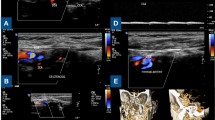Summary.
Summary.
Background and Purpose:
Carotid Bodies (CB) are fed mainly by External Carotid Artery (ECA) and rarely by Internal Carotid Artery (ICA). We aimed to investigate the effect of Bilateral Common Carotid Artery ligation and BCCAL plus bilateral external carotid artery ligation on CB.
Methods:
This study has been conducted on 30 hybrid male rabbits. Normal CB analyses were made in six of these animals and others divided into two groups. BCCAL has been applied to the 1st group, and the 2nd group has undergone bilateral ECA ligation in addition to BCCAL. After sacrificing the animals, both sides CB were histopathologically observed. Normal and ischemic cells were counted.
Findings:
Bilateral Common Carotid Artery ligation did not cause total atrophy in CB. Partial reversible atrophy of CB was seen in group I, but that atrophy was found to be irreversible and all animals died within one week after ligation in group II.
Interpretation:
Retrograde blood flow mechanisms and collateral circulation impede the oligemic CB atrophy after BCCAL. But bilateral ECA ligation, in addition to BCCAL, causes both sides irreversible CB atrophy and death of animals within one week of ligation.
Abstract:
The CB are parasympathetic paraganglia. They are chemoreceptors and located at the bifurcation zone of common carotid arteries. They are fed mainly by ECA or by its branches and rarely by ICA. As a consequence of this, BCCAL and/or ligation of external branches of common carotid artery may lead to an ischemic impairment of CB. In order to analyse the effect of carotid stenosis on CB, CB were directly examined in 6 of 30 hybrid rabbits. BCCAL was applied to twelve rabbits (group I) with ligation of both ECA in addition to BCCAL were made to the others (group II). Animals were followed up four months in group I; but all of the animals in group II died within one week. From both sides the CB were taken including the carotid bifurcation and histopathological changes were evaluated. As a result, it has been observed that incomplete ischemic lesions have developed in the CB because of retrograde blood flow from posterior circulation to the ECA providing blood for the CB. But in the second group these changes were irreversible and on both sides CB complete atrophy developed in those whose ECA were also ligated bilaterally.
Similar content being viewed by others
Author information
Authors and Affiliations
Rights and permissions
About this article
Cite this article
Aydin, M., Özkan, U., Gündoğdu, C. et al. Protective Effect of Posterior Cerebral Circulation on Carotid Body Ischemia. Acta Neurochir (Wien) 144, 369–372 (2002). https://doi.org/10.1007/s007010200051
Issue Date:
DOI: https://doi.org/10.1007/s007010200051




